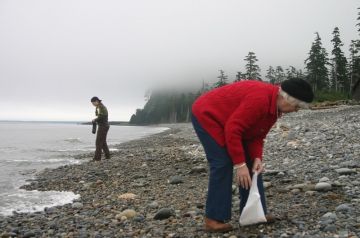Agate Beach, Naikoon Provincial Park

Park Amenities:
Agate Beach, Naikoon Provincial Park
Many come to visit this vast rocky, sandy beach to browse and identify various rocks, stones and pebbles while exploring up and down the shores. The salty moist breeze, the miles of sand and rock, the rhythm of the waves, the rolling of the rocks and the squawk of the seabirds makes for a great day exploring when visiting Agate Beach.
 The stones, pebbles and rocks on Agate Beach are plentiful, come in all sizes, are multi-colored, many are round and smooth from many years of exposure to the west coast winds and powerful oceans. The waves come crashing down onto the shoreline, raking stones back and forth, up and down the beach creating beautiful music polishing stones. High tides have pushed the rocks far inland forming a coastline ridge of rock and driftwood.
The stones, pebbles and rocks on Agate Beach are plentiful, come in all sizes, are multi-colored, many are round and smooth from many years of exposure to the west coast winds and powerful oceans. The waves come crashing down onto the shoreline, raking stones back and forth, up and down the beach creating beautiful music polishing stones. High tides have pushed the rocks far inland forming a coastline ridge of rock and driftwood.
Many arrive at Agate Beach to find agate rock. A hard task for most is to pick an agate rock out from the millions of beautiful coloured rocks spilled over the beach. Agate colour varies too - from a clear-white, to yellowish-amber, greens and red. The same colours as many other rocks too. The trick is is to find an irregularly shaped stone, translucent with pock marks.
Agate is created from solutions of silica at relatively shallow depths and low temperatures. It is a rock that is sensitive to the physical and chemical conditions surrounding it. It is associated with the opal. Fossilization, soil formation, and alteration of existing rock can all create agate. A pretty rock when polished and often used in jewelry.
Agate Beach, Naikoon Provincial Park, Haida Gwaii, BC, Canada
Address:



